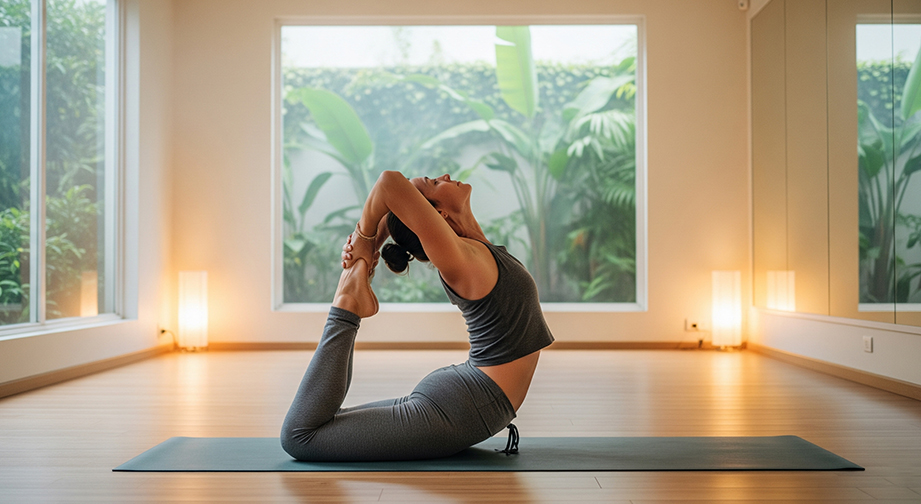Rajakapotasana (King Pigeon Pose): A Detailed, Empathetic Guide
Introduction
Rajakapotasana, or King Pigeon Pose, is one of yoga’s most graceful and empowering postures. In Sanskrit, “raja” means king, “kapota” means pigeon, and “asana” means posture. The essence of this pose is opening and releasing — it brings a deep sense of freedom to the hips and the heart.
If you’ve ever felt stiff after a long day sitting at your desk, or want to release pent-up tension in your hips and lower back, Rajakapotasana might become your new best friend. This beautiful pose offers a pathway to both emotional release and physical flexibility.
Step-by-Step Guide to Rajakapotasana (King Pigeon Pose)

- Start in Downward-Facing Dog (Adho Mukha Svanasana).
- Exhale as you lift your hips, straightening your spine.
- Bring Your Right Knee Forward toward your right wrist.
- Place your right ankle near your left wrist, shin diagonal or parallel to the mat — whatever feels comfortable.
- Inhale gently, lengthening your spine.
- Slide Your Left Leg Back straight behind you, with the top of your left foot resting on the mat.
- Keep your hips square and facing forward, not tilting to one side.
- Lift Your Chest and walk your hands back beside your hips.
- Inhale to lift your heart, rolling your shoulders down and back.
- Option to Fold Forward over your right shin for a more passive pigeon.
- Exhale as you lower your torso and rest your forehead on your hands or a block.
- Hold the Pose
- Breathe deeply: inhale to lengthen, exhale to relax deeper.
- Stay for 5–10 breaths (about 30–60 seconds).
- Release and Switch Sides
- Exhale as you gently come out and back to Downward Facing Dog, then repeat on the other side.
Beginner Modifications:
Place a block or blanket under your right hip for support if it doesn’t reach the floor. Flex your front foot to protect your knee.
Intensifications for Advanced Practitioners:
To deepen into full King Pigeon, bend your back knee, reach your hand (or use a strap) to catch your foot, and gently draw it toward your head.
Alignment & Safety Tips
- Alignment Cues: Keep hips squared to the front; avoid collapsing onto one side.
- Common Mistakes: Don’t force the front shin parallel; don’t let your back leg splay out.
- Safety Precautions: Avoid if you have knee, hip, lower back, or sacroiliac injuries. Pregnant practitioners, or those with hip replacements, should skip this pose or modify heavily.
Benefits of Rajakapotasana
Physical Benefits
- Stretches hips, glutes, and hip flexors
- Opens the chest, shoulders, and back (in the advanced version)
- Improves posture and spinal flexibility
- Relieves lower back and sciatic discomfort (with correct alignment)
Mental Benefits
- Promotes deep relaxation and stress release
- Encourages letting go of emotional tension
- Brings a sense of calm and presence
Energy / Chakra Connection
- Activates the Sacral Chakra (Svadhistana), seat of creativity and emotions
- Opens the heart chakra (advanced version)
Contraindications
- Avoid if you have acute knee, hip, or lower back injuries.
- Pregnant women should skip or use gentle alternatives.
- People with sciatic pain, always proceed with caution and consult your healthcare provider.
Safe Alternative: Thread the Needle Pose (Supine Figure-4 Stretch) is an excellent, gentle hip opener.
Beginner’s Tips & Variations
- Props: Use a folded blanket or bolster under your hip and a block under your chest or forehead for support.
- Gentle Variation: Keep the front leg closer to your body and don’t worry about shin alignment—just focus on sensation, not form.
- Advanced Variation: Try Full King Pigeon by bending the back knee and reaching for your foot with your hand (or a strap for shoulders).
How to Include Rajakapotasana in a Yoga Flow
- Best used after warming up — try practicing after several rounds of Sun Salutations or hip-opening poses.
- Pairs well with:
- Lizard Pose (Utthan Pristhasana)
- Low Lunge (Anjaneyasana)
- Seated Forward Bend (Paschimottanasana, for a cooling counterpose)
- Excellent as a main practice or deep relaxation toward the end of your class.
Mind-Body Connection
Be mindful of your breath, letting each inhale lengthen your spine and each exhale melt away tension. Notice emotions or thoughts that arise—hips often hold stress and old feelings, so allow yourself patience and compassion. Rajakapotasana is said to enhance the creative and emotional flow by opening the sacral chakra.
Summary Box
- Asana Name: King Pigeon Pose (Rajakapotasana)
- Level: Beginner to Intermediate (with advanced variation)
- Focus Areas: Hips, hip flexors, chest, shoulders, back
- Duration: 30–60 seconds per side (up to three rounds)
- Best Time to Practice: Morning or evening, after warm-up
FAQs About Rajakapotasana (King Pigeon Pose)
Q1: Is King Pigeon Pose safe if I have tight hips?
A: Yes, with modifications! Use props and don’t force your shin or hips. Ease in and focus on sensation over depth.
Q2: What should I do if my knee hurts in Rajakapotasana?
A: Come out immediately and try a gentler hip opener, like Thread the Needle. Always protect the knee in this pose.
Q3: How often can I practice Rajakapotasana?
A: Daily is fine, as long as you warm up and listen to your body.
Practice Rajakapotasana (King Pigeon Pose) gently and consistently, and you’ll notice your hips, heart, and mind opening more each time. Remember: be kind to yourself, listen to your body, and enjoy the journey!